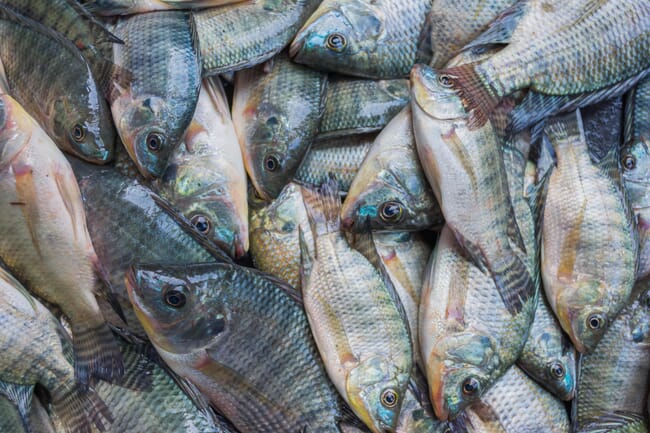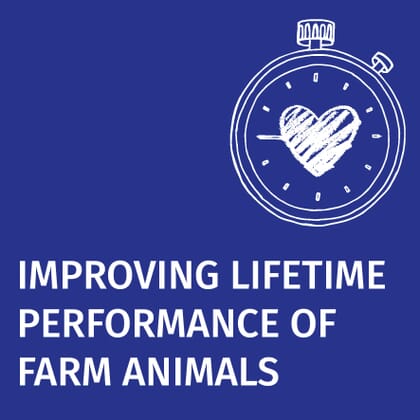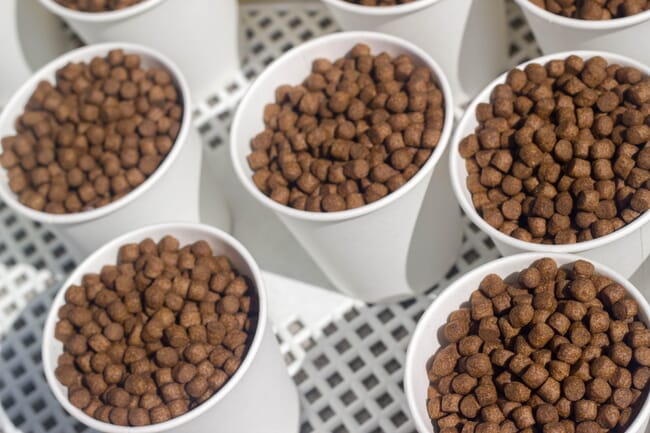
Supplementing aquafeeds with protease, carbohydrase and phytase enzymes can improve numerous key performance areas in both fish and shrimp farming
The aim of this article is to highlight the ways in which supplementing feeds with protease, carbohydrase and phytase enzymes can improve outcomes for each of these factors relating to farm animal performance.
1. Genetic potential for growth
This is based on the degree of domestication, plus any genetic improvement. A typical farm will seek out fish fingerlings and shrimp post-larvae (PL) from a convenient reputable hatchery, based on historical performance. A hatchery will often provide growth rate data so the farmer can determine whether performance on the farm is at standard, above standard or below standard.
One area where breeding programmes for genetic improvement are lagging is in enhancing the ability of omnivorous and carnivorous fish and shrimp to better utilise protein, amino acids and lipids in plant-based ingredients. As the worldwide aquaculture industry strives to become more sustainable through the reduction of fishmeal in feeds, the ability of aquatic animals to effectively digest and absorb all the nutrients in alternative feed ingredients used in low fishmeal feeds becomes more and more important. The salmon and trout farming industries have begun to select and breed animals that are more tolerant of soybean meal and other vegetable proteins (Quinton 2007, Overturf 2013, Callet 2017), but selective breeding for vegetable ingredient tolerance has not begun for Asian farmed fish and shrimp species yet.
What, specifically, is the issue with plant-based feed ingredients that would benefit from selective breeding programmes? Improving digestibility and utilization of carbohydrates for energy will spare more protein and fat for growth. Excluding herbivorous species, most fish have not evolved the enzyme capacity to digest carbohydrates other than simple sugars because carbohydrates are not found in their natural prey diets (Wilson 1994, Polakof et al. 2012). Even then, much of the digestive capacity of fish that can utilise carbohydrates comes from bacterial fermentation by gut microbiota resident in their intestines (Kihara and Sakata 1997). In most cereals and grains, carbohydrate energy, protein and lipids are largely unavailable to fish because they are locked inside cell walls made from complex polysaccharides like lignin, hemicellulose, glycans, mannans and xylans.

Rather than waiting for long-term genetic improvement programmes to modify fish to be better at utilising plant-based ingredients, the rapid solution is to immediately start using carbohydrase enzymes in feed. Enzymes to assist digestion of complex carbohydrates – among them amylases, glucanases, mannanases and xylanases – have been used in poultry feeds for decades, and research with fish and shrimp has shown that these enzymes work well when added to aquafeeds for many species. These enzymes increase available dietary energy by converting starch oligosaccharides and non-starch polysaccharides (NSP) into simple sugars, and by breaking down cell walls, unlock more protein and lipids to be extracted and utilised by animals. The secret to using carbohydrase enzymes most effectively is to match the enzyme or combination of enzymes specifically designed to break down the indigestible carbohydrates found in most plant-based feeds. For example, a feed high in soybean meal could benefit from adding a combination of galactosidase, glucanase and mannase, to break down the equivalent NSPs prominent in soybean meal.
2. Optimal environmental conditions
Since aquatic animals are unable to control their body temperature, keeping water temperatures in the optimal range is essential to attain maximum growth. Temperatures below the optimal range reduce feed intake, a result of depressed metabolism and reduced energy needs, leading to slow growth. Temperatures above the optimum range cause metabolic processes to race, wasting energy and nutrients. Extreme temperatures, either high or low, will result in death and high mortality of the farm crop. Among metabolic processes, the effect of temperature on the rate at which numerous enzymes work is perhaps the most relevant, since efficiency of digestive processes and nutrient uptake are highly enzyme dependent.
Just like endogenous enzymes, feed enzymes also have a temperature-activity profile, but feed enzymes have an advantage in that they can be designed to work effectively across a wider temperature range. It is common to see growth slow down at low temperatures, partly due to reduced feed intake, but also due to reduced digestive activity and capacity impacting nutrient absorption. Furthermore, as intake of essential nutrients declines, weakened immunity is also observed, and for many species, pathogens are waiting to initiate diseases. A clever strategy is to supplement winter feeds with phytase and protease, supercharging endogenous protein digestion and increasing nutrient uptake by destroying protease inhibitors and preventing phytic acid from binding essential nutrients like phosphorus, amino acids, trace minerals and vitamins. This concept is supported by research by Rodehutscord and Pfeffer (1995) who found that, even at 10°C, rainbow trout (Oncorhynchus mykiss) fed 1000 units/kg diet of an Aspergillus niger phytase saw a three- to four-fold increase in P deposition and P utilisation compared with control trout that were not given phytase in their feed.

There are several species, including tiger prawns (pictured) or the striped river catfish (Pangasianodon hypophthalmus) that are very successfully being produced with incomplete nutritional data
3. Providing a nutritionally complete and properly balanced feed
This is a real challenge for many farmed aquatic species because nutrient requirements have not been determined, but there are several species, such as the white-legged shrimp (Litopenaeus vannamei) or the striped river catfish (Pangasianodon hypophthalmus) that are very successfully being produced with incomplete nutritional data. The benefits of having a complete determination of nutrient requirements are, of course, better dietary balance, improved efficiency of growth and feed utilisation, reduced costs and improved profits. Fishmeal has been the preferred ingredient in aquafeeds in the modern era because it is easy to digest and provides all key nutrients in excess of known or unknown requirements, while nutrient profiles for amino acids, lipids and minerals closely match the real needs of fish and shrimp. With the reduction of fishmeal and the increase in use of alternative plant proteins there is increased risk of failing to provide adequate nutrition. For example, Hemre et al. (2016) reported that they had to increase levels of B-complex vitamins in Atlantic salmon (Salmo salar) feeds containing high levels of plant-based ingredients to maintain feed performance. The presence of phytic acid in some important plant-based ingredients has a big impact on phosphorus and trace mineral nutrition, reducing uptake of P and zinc in particular.
4. Farm management practices
Maintaining optimal health and well-being of farmed animals is a very important factor in how well they grow and whether they survive to harvest or not. In other words, achieving a high farm yield guarantees a high profit for the crop, which is what every farmer hopes for and dreams about. Optimising stocking density to maximise use of space while keeping stress at low levels is perhaps the most critical factor, while avoiding physical damage and high stress caused by improper handling practices leading to weakened immunity, increased risk of pathogenic attack and disease is also very important.
5. Excellence in managing feeds and feeding
These should be the farmer’s goal. The total amount of feed used and cumulative cost of feed at harvest is the single most important factor in determining a farmer’s profit, because for most farmers, feed is the largest investment made in a crop cycle, often 50-60 percent or more of total operational costs. Here, achieving the best feed efficiency (FE), or feed conversion ratio (FCR) is the key to success, and this depends on feeding animals when they are hungriest, and feeding to satiation and not more. The rule of thumb is “feed the fish, not the water”. And, of course, feed quality is really important, as you will learn. Mismanagement of feeding leads to poor performance and increased costs, but also decreased water quality due to increased nitrogen and phosphorus loading (see below).

6. High feed digestibility and high assimilation of essential dietary nutrients
A knowledgeable, qualified nutritionist will always recommend that a farmer uses the most expensive feed they can afford to suit the management practices they use. Cost of feed alone is not the issue, rather total cost of feed used compared to total profit at harvest. Higher priced feeds tend to be made with better raw materials, are more digestible, and give a better FCR, so total feed cost is reduced, increasing profitability per kilogram of fish produced.
The protein, fat, energy and vitamin levels in feed must be optimized to suit the species, must be matched to the farming intensity (eg extensive, semi-intensive, intensive), and must consider the vulnerability of the chosen species to stress effects coming from nutritional stress, oxidative stress, crowding stress, handling stress, pathogen stress, and stress induced by poor water quality coming from nitrogen and phosphorus loading (eg uneaten feed wastes, excreted wastes).
The incorporation of high-phytate content ingredients coming from legumes, cereals and grains has a big impact on dietary uptake by reducing availability of protein (Selle et al. 2000, Spinelli et al. 1983) and the trace minerals zinc (McClain and Gatlin III 1998), manganese (Storebakken et al. 1998), iron and copper (Papatryphon et al. 1999). Supplementing feeds with microbial phytase can improve availability of these trace minerals (Storebakken et al. 1998, Papatryphon et al. 1999, Selle et al. 2000). For further information, Kumar et al. (2012) have written an excellent review about phytate and phytase in fish feeds.
7. Optimal water quality – eg dissolved oxygen, dissolved nitrogen, pH
Any uneaten feed or poorly digested feed leads to excessive waste deposition in the water. Waste carbon, nitrogen and phosphorus increase oxygen consumption by water and soil (measured as COD – chemical oxygen demand) leading to anaerobic conditions, and provide the perfect substrate for growth of microorganisms (measured as BOD – biological oxygen demand). Excess P in the water has two negative consequences:
- Increased algal growth (algal blooms), which significantly drops dissolved oxygen levels during early morning hours, increasing stress and the likelihood of poor growth and survival. Operating costs increase because aeration equipment has to be installed and running on cloudy days and overnight.
- Eutrophication and the growth of cyanobacteria, which produce geosmin and 2-methylisoborneol (MIB), two compounds responsible for creating those undesirable off-flavours in fish flesh that consumers dislike.
In intensive aquaculture with heavy feed application, there is significant benefit obtained by using a combination of feed enzymes (eg phytase, xylanase and protease) to increase protein digestibility and reduce the antinutritional effects of NSPs and phytic acid. Feed performance is improved with better digestibility, the FCR is decreased because nutrient absorption improves, and with reduced excretion of nitrogen and phosphorus, high water quality can be maintained.
By now it should be obvious just how important these seven factors are in successfully bringing an aquaculture crop to harvest while keeping FCRs down and growth performance and profits up. During DSM's Evidence Matters - Performance campaign, upcoming articles will focus on several of these factors in more depth.




